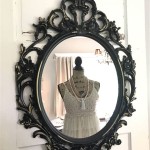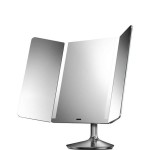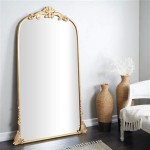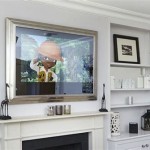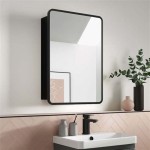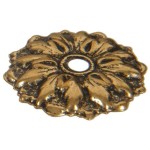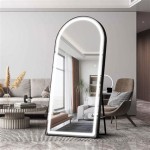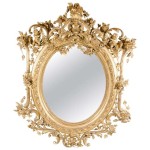How To Hang a Mirror on a Plaster Wall
Hanging a mirror on a plaster wall presents unique challenges compared to drywall. Plaster is harder and more brittle, requiring specific techniques to ensure a secure and damage-free installation. This article outlines the necessary steps and considerations for successfully hanging a mirror on a plaster wall.
Assessing the Wall and Mirror
Before beginning, evaluate both the plaster wall and the mirror. This assessment informs the best hanging method and necessary hardware.
- Check for Existing Damage: Examine the plaster for cracks, loose sections, or previous repairs. These areas may require additional support or patching before hanging the mirror.
- Locate Studs: Using a stud finder, identify the location of wall studs. Hanging heavy mirrors directly on studs provides the most secure support.
- Determine Mirror Weight: The mirror's weight dictates the appropriate hanging hardware. Heavier mirrors require more robust fasteners. Weigh the mirror using a bathroom scale if the weight is unknown.
- Examine Mirror Backing: Check the mirror's back for existing hanging hardware, such as D-rings or wire. This will influence the type of hooks or fasteners needed.
Choosing the Right Hanging Hardware
Selecting the correct hardware is crucial for a secure installation. Consider the following options based on the mirror's weight and the wall's condition.
- Heavy-Duty Picture Hooks: For lighter mirrors on sound plaster, heavy-duty picture hooks rated for the mirror's weight can be used. These hooks often leave smaller holes than other options.
- Plaster Screws: Specifically designed for plaster, these screws have a coarse thread that grips the material effectively. They are suitable for moderate-weight mirrors.
- Toggle Bolts: For heavier mirrors or areas with damaged plaster, toggle bolts offer superior holding power. They require drilling a larger hole but provide a secure anchor behind the plaster.
- Wall Anchors: Various types of wall anchors, including plastic expansion anchors and molly bolts, can be used in conjunction with screws to provide additional support in weaker plaster areas.
Preparing the Wall
Proper wall preparation ensures a secure and long-lasting installation. Follow these steps to prepare the plaster surface.
- Mark the Desired Location: Use a pencil and level to mark the desired position of the mirror on the wall. Carefully measure and ensure the markings are accurate.
- Pre-Drill Pilot Holes (If Necessary): For plaster screws, toggle bolts, and certain wall anchors, pre-drilling a pilot hole is essential to prevent cracking the plaster. Use a drill bit slightly smaller than the fastener's diameter.
- Patch Damaged Areas (If Necessary): Repair any cracks or loose plaster using a suitable patching compound. Allow the patch to dry completely before proceeding with the installation.
Installing the Hanging Hardware
With the wall prepared, the next step is to install the chosen hanging hardware.
- Insert Hardware Carefully: Insert the chosen hardware—picture hook, plaster screw, toggle bolt, or wall anchor—following the manufacturer's instructions. Avoid excessive force to prevent damage to the plaster.
- Ensure Secure Placement: Verify that the hardware is firmly in place and can support the mirror's weight. Gently tug on the hardware to test its stability.
Hanging the Mirror
The final step involves carefully hanging the mirror on the installed hardware.
- Align and Hang: Carefully align the mirror's hanging hardware—D-rings, wire, or keyhole slots—with the installed hooks or fasteners on the wall.
- Check Stability: Once the mirror is hanging, gently shake it to confirm its stability. Ensure the mirror is level and hangs flush against the wall.
- Clean Up: Remove any pencil marks and dust from the wall around the mirror.
Tips for Hanging Mirrors on Plaster Walls
Consider these additional tips for a successful installation.
- Use a Level: Employ a level throughout the process to ensure the mirror hangs straight.
- Consider Adhesive: For very lightweight mirrors, mirror adhesive can be used as an alternative to traditional hanging hardware.
- Seek Professional Assistance: For extremely heavy or valuable mirrors, or if dealing with significantly damaged plaster, consult a professional handyman or installer for assistance.
Safety Precautions
Prioritizing safety is paramount when working with tools and hanging heavy objects.
- Wear Safety Glasses: Protect your eyes from dust and debris when drilling or hammering.
- Use a Stud Finder Correctly: Ensure accurate stud location to prevent accidental electrical wire damage.
- Enlist Help for Heavy Mirrors: If the mirror is too heavy to manage safely alone, enlist the assistance of another person.
:strip_icc()/ScreenShot2022-04-28at1.12.19PM-e055476c70c6438585fa7c5cd531edcf.png?strip=all)
4 Easy Ways To Hang A Heavy Mirror
How To Hang A 100 Pound Mirror On Drywall Quora

How To Hang A Very Heavy Picture Or Mirror The Best

How To Hang A Large Or Heavy Mirror

How To Hang A Heavy Picture On Plasterboard Wall
Hanging Heavy Framed Mirrors Lath Plaster Walls The Picture Framers Grumble

A Better Way To Hang Heavy Mirror Hanging Pictures

How To Hang A Heavy Mirror On Drywall Stas Picture Hanging Systems

How To Hang A 31kg Mirror On Wall With Bunnings Work Community

How To Hang A Heavy Mirror The Home Depot

